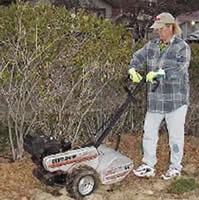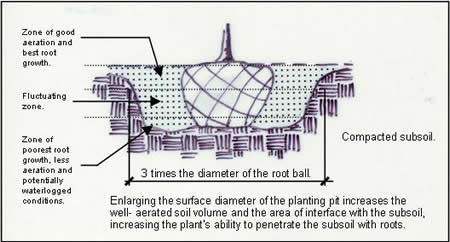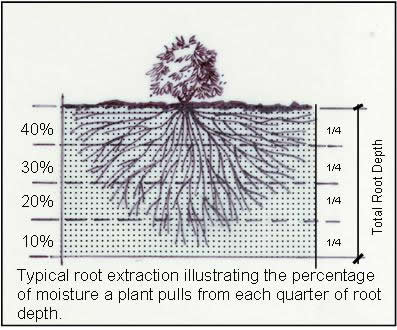Principle #2
Condition Your Soil Through Soil Improvements
Grow Good Soil
 Improving
your soil is one of the best investments you can make
toward a successful landscape. One common ailment of
most western soils is that they are low in organic
materials
and have a high pH, meaning that they are alkaline.
High alkalinity reduces essential soil elements needed
for proper plant growth. Many soils around the built
environment also suffer from compaction created by
foot
traffic, auto traffic, and machinery traffic during
construction. Compaction restricts the movement of
air
and water which is essential for good root development.
Good root development is a key factor in the ability
of a plant to withstand drought conditions. Adding
an inch or two of compost, peat moss, or aged manure
rototilled
thoroughly to a depth of six inches will help to improve
the soil structure and moisture-retaining capacity
while
buffering the soil alkalinity. Another common problem
with soils in our area is that soils are too sandy
or
too heavy with clay. To help alleviate this problem
use the same approach. Organic material in clay soils
will improve the soil’s ability to release more
water to plants and will allow air movement. The same
amendment in sandy soils will help it to hold water
for longer periods of time. Improving
your soil is one of the best investments you can make
toward a successful landscape. One common ailment of
most western soils is that they are low in organic
materials
and have a high pH, meaning that they are alkaline.
High alkalinity reduces essential soil elements needed
for proper plant growth. Many soils around the built
environment also suffer from compaction created by
foot
traffic, auto traffic, and machinery traffic during
construction. Compaction restricts the movement of
air
and water which is essential for good root development.
Good root development is a key factor in the ability
of a plant to withstand drought conditions. Adding
an inch or two of compost, peat moss, or aged manure
rototilled
thoroughly to a depth of six inches will help to improve
the soil structure and moisture-retaining capacity
while
buffering the soil alkalinity. Another common problem
with soils in our area is that soils are too sandy
or
too heavy with clay. To help alleviate this problem
use the same approach. Organic material in clay soils
will improve the soil’s ability to release more
water to plants and will allow air movement. The same
amendment in sandy soils will help it to hold water
for longer periods of time.
Remember that organic material such as in any soil
is the primary source of nutrients to plants. The addition
of aged organic materials such as compost, aged sawdust
or manure also “inoculates” the soil with
colonies of beneficial bacteria. These bacteria help
to speed the decomposition rates of organic materials
in the soil. Over time this process actually “grows”
good soil.
Planting Strategy
When planting large trees dig the tree hole 3
times the diameter of the root ball and exactly
as deep as the root ball. Set the root ball on
undisturbed soil at the bottom of the hole. This
will prevent settling of the root ball. Do not
amend the backfill. Contrary to popular belief,
amending the backfill will encourage roots to
stay within the planting hole rather than expanding
outward into native soils. The hole is dug 3 times
the diameter of the root ball because the loosened
soil around the root ball will allow better movement
of air and water, which stimulates root growth
to explore the native soil surrounding the tree
hole.

Soil Amendments Tip
Many native plants do better with no soil improvements.
Use amendments only with appropriate non-native,
adapted plants. Typically soil amendments should
be focused in the High Water Use Zone and Moderate
Water Use Zone. Soils in turf areas, especially
bluegrass, should always be amended.

|
|

